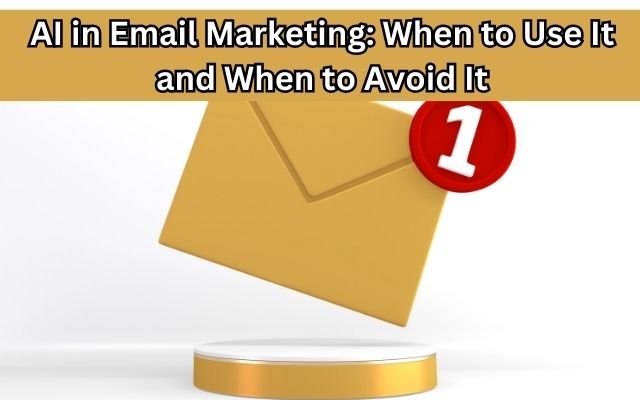AI for Email Marketing: Knowing When to Use It Wisely
Discover when to use AI for email marketing and when a personal touch is needed to keep your messages engaging, effective, and authentic.

AI can draft emails in seconds, making communication quick and easy. But not every email should be automated. Some benefit from AI, while others need a personal touch to keep them authentic and engaging.
When using AI for Email Marketing, it’s essential to determine the right balance between automation and human input. AI can be quite helpful in creating newsletters, follow-ups & promotional emails while ensuring efficiency and consistency. However, a human-written email is frequently more effective when answering sensitive questions, resolving client concerns, or building connections.
Knowing when to rely on AI and when to create emails yourself is essential to employing it in email marketing. You may develop a more captivating & successful email campaign by striking a balance between human interaction & AI-generated content.
AI Works Well for Simple Emails
For simple emails, like scheduling or confirming details, AI can be a great tool to speed up your response time. If email doesn’t require much creativity or deep thinking, letting AI generate a reply is usually a good option.
Try using a suggestion such as “Write a short, professional reply to email below & suggest a meeting at 11 AM” when scheduling a meeting.
AI can generate a well-organized response fast, saving you time while maintaining professionalism and clarity. A personal touch, however, might still be desirable for more complex conversations.
Table of Contents
AI Can Manage Overflowing Inboxes
If your inbox is overflowing with emails from colleagues, responding to each one can feel overwhelming. While AI isn’t ideal for emails that require originality, it can be a useful tool to speed up the drafting process.
For instance: you can jot down key points for your response and let AI turn them into a polished email. This approach saves time while keeping your message clear and professional.
AI can also assist with managing your inbox. Tools like Outlook’s Copilot, Grammarly and Sanebox help you sort, summarize and prioritize emails, making it easier to stay on top of your workload.
AI Can Improve Your Writing
AI technologies like ChatGPT can help if you ever have trouble writing emails by enhancing your draft and improving your ideas. You can use an AI tool to paste your email and ask for recommendations for changes, extra ideas or a more polished rewrite.
Using AI in this way doesn’t replace your original thoughts—it simply helps you organize and enhance them, making your emails clearer, more polished and more effective.
Avoid AI for Emails Requiring Creativity and Critical Thinking
AI is useful for basic replies, but it’s not the best choice when creativity and critical thinking are needed. It can assist with drafting emails, but it shouldn’t replace your own voice in important conversations. When a friend, manager, or coworker asks for your opinion, they want to hear your thoughts—not a response generated by AI. While AI can be a helpful tool, relying on it too much may make your communication feel impersonal. In crucial discussions, it’s always best to share your own insights and perspective rather than letting AI speak for you.
Using AI to refine your writing or organize thoughts is fine, but relying on it entirely can remove authenticity from your message. Your unique perspective, insights, and experience add value that AI simply can’t replicate.
Don’t Use AI If You Can’t Review It
Responses from AI language models are frequently verbose and repetitious. AI-generated writing typically requires modification unless you are really good at creating prompts or give detailed information. Blaise Pascal once said, “If I had more time, I would have written a shorter letter,” and the same applies to AI-assisted writing—refining and shortening content takes effort.
To improve AI-generated emails, it’s helpful to add specific instructions like “concise” in your prompts. AI responses may still seem generic even then & they still need to be significantly edited for clarity and uniqueness. Instead of depending only on AI output, a simple meeting request, for instance, can seem more natural with personal changes.
Additionally, depending on AI might not be best course of action if your place of employment limits AI-generated content or uses AI-detection techniques. False positives can occasionally identify your writing as AI-generated even if AI isn’t helping. Accordingly, it’s wise to proofread & edit AI-generated texts before utilizing them in formal correspondence.
AI May Not Always Be Respectful
What takes you a few seconds to create in AI email may take the receiver a lot longer to read. AI-generated emails frequently come across as wordy and impersonal which frustrates readers and hinders communication. AI-written emails that were too long and obviously took less time to write than I did to read had been sent to me.
AI can boost productivity, but it’s important to respect the recipient’s time. Before using AI for an email, ask yourself: Am I making communication easier, or am I just offloading effort onto someone else?
AI is great for drafting simple emails, refining outlines, or assisting with clarity. But if you’re using AI just to avoid writing a thoughtful response, it might be best to write it yourself—or say nothing at all.
- How Do I Change My iPhone Charging Sound?
- 4 Ways to Open Network Connections in Windows
- Top 5 AI-Powered Tips for Growing Your Instagram with AdCreative.ai
FAQs on Using AI for Email Marketing
1. Can AI write all my emails for me?
No, simple messaging like newsletters, scheduling, and confirmations are where AI works best. However, write your own emails if they require originality or a personal touch.
2. How can AI help me manage my overflowing inbox?
AI tools like ChatGPT, Outlook’s Copilot, Grammarly and Sanebox can help sort, summarize, and prioritize emails. AI can also assist in drafting replies, making email management more efficient.
3. Is it safe to use AI-generated emails in professional settings?
It depends on your organization’s policies. Some companies restrict AI-generated content or use AI-detection tools. Always review and edit AI-generated emails to maintain professionalism and originality.
4. What’s the best way to prompt AI for email writing?
Use clear, concise prompts like: “Write a short, professional reply to the email below and suggest a meeting at 11 AM.” Adding instructions like “concise” or “formal” helps refine the AI’s response.
5. How do I ensure AI-generated emails don’t sound robotic?
Edit the AI-generated content to add your unique voice. Keep sentences clear and to the point, and remove unnecessary repetition to make your emails more natural and engaging.



